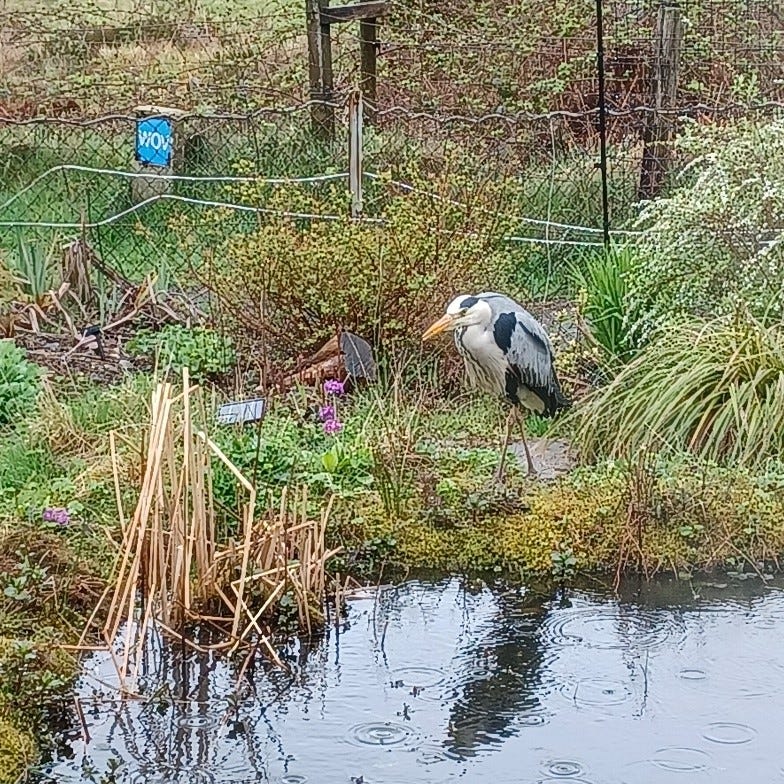Build it, and They Will Come
Michelle's experience is that nature shows up to party when water is involved
Have you ever thought about giving a homemade mini pond kit as a birthday present? It’s a great idea that combines the fun of giving gifts with learning about nature. This sort of gift keeps on giving - right in your own garden.
Scotland alone has an estimated 198,000 ponds, according to the Countryside Survey 2007. Ponds are a special type of freshwater habitat that feel both ancient and persistent. Yet, many ponds, like those formed by meandering rivers or fallen trees, are naturally short-lived and often fill themselves in within decades.
Historically, humans have created ponds for a variety of reasons—mill ponds, duck ponds, dye ponds, old farm ponds, fish ponds, ornamental garden ponds, livestock watering ponds, watercress beds, and even swannery ponds, to name a few. These human-made ponds have historically added new ways to maintain an ancient and natural habitat in our post industrial modern landscape.

Let me take you through my own experience of turning my interest in ponds into a wildlife haven at home. My story is all about how a little effort and enthusiasm can bring nature closer in wonderful ways.
Ever since I was a child, I loved making tiny ponds from things I found around the house, and seeing what would move in. This childhood hobby ultimately grew into a deeper love for teaching others about the wonders of natural ponds and the life they hold.
When we were all stuck at home during the lockdowns of 2020, I finally got the time to make my dream of having my own (smallish) garden pond come true. It served as the perfect distraction from the gravity of the world’s pandemic as well.
Even though my garden in Lochaber is rocky and tough to dig, I was determined to make it work. Digging out the rocks and laying down a pond liner was hard work - but well worth it.


After setting the liner, I added gravel, filled it with water, and arranged the soil and stones around the edges. This was just the beginning of creating a new ecosystem. I planted native flowers and plants that attract bees and butterflies and made sure there were plenty of places for wildlife to thrive. Before long, birds such as sparrows, dunnocks, bramblings, tits, blackbirds, and even a hunting grey heron started showing up, proving that the pond was making a real difference.


As time went on, the pond became alive with a fascinating variety of creatures: palmate newts, common toads, frogs, damselfly nymphs, golden ring dragonflies, whirligig beetles, pond snails, and water skaters. The underwater plant life flourished too, with species like water mint, willow moss, water lilies, iris flags, marsh marigold, and meadow sweet enhancing the aquatic landscape. I added an oxygenator as the pond I had made didn’t have an active inflow (these are actually very reasonable you can pick up a solar powered one for about £20).

Adding a simple underwater camera, or endoscope, lets you see underwater and appreciate the smaller creatures that are easy to miss. Studies have shown that pond colonisation is usually a very rapid process, especially where other wetland habitats are nearby. There’s no need to add plants or animals; nature takes over quickly. Build it….and they will come!
This mini pond is a gift that keeps on changing and surprising. From frogs laying eggs to tadpoles turning into frogs, and birds visiting - even a Heron! There’s always something new to see.
Having a pond in your garden isn’t just about biodiversity; it’s also a boon for mental health. The tranquil waters and the soft sounds of nature provide me with a peaceful retreat from the hustle and bustle of daily life, helping to reduce stress and enhance mental wellbeing. It's a place where I can relax, unwind, and reconnect with nature in my own space, offering therapeutic benefits that I find hard to find elsewhere.
This whole experience is a perfect example of how small projects can have a big impact on the environment and your own health. So give it a go!
Remember when enjoying or creating ponds, especially in urban areas, safety is crucial. Always follow water safety advice from the Royal Society for the Prevention of Accidents (RoSPA) to keep safe near water bodies.
Michelle Melville is High Life Highland’s Heritage Ranger, is passionately dedicated to preserving Scottish natural and cultural heritage. A skilled artisan, Michelle excels in a range of hand crafts from carving and weaving to stained glass creation and needle felting. Her talent in these crafts forms a vital part of her role in engaging and inspiring communities to be inspired by their environment, and learn new skills and gain in confidence.







Super video Michelle - sharing that direct experience of how nature and activity supports mental health! I'm sure it will help others to share this.
It was a very useful article, thank you